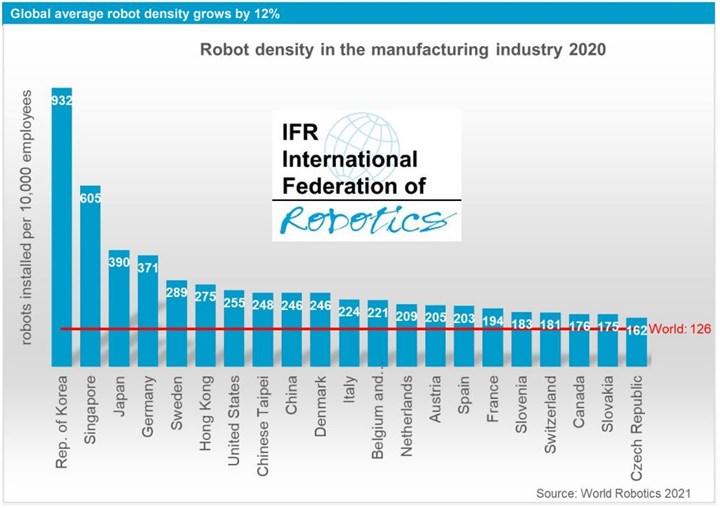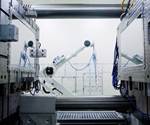Global Robot Density Nearly Doubles
The number of robots per 10,000 employees globally jumped from 66 in 2015 to 126 in 2020, rising 45% in the U.S. from 176 to 255 units over the same time period.
The International Federation of Robotics’ (IFR) 2021 World Robot Statistics report shows a quickening acceleration of robot adoption by industry all around the world. The robot density metric—robots per 10,000 employees—jumped from 66 to 2015 to 126 just five years later.
IFR reports that on a geographic basis, Asia/Australia leads the world at 134, units, followed by Europe (123) and the Americas (111). The top five most-automated countries in the world are: South Korea, Singapore, Japan, Germany, and Sweden. The U.S., which saw its density rise from 176 units in 2015 to 255 units in 2020, ranks seventh globally ahead of Taiwan (248) and China (246).
Over that time period, China’s density climbed more than any other country’s, nearly quintupling from from 49 units in 2015 to 246 units in 2020. China’s robot density now ranks ninth globally compared to 25th back in 2015.
China’s neighbor, South Korea, remains the most automated nation, retaining a title it’s held since 2010, with a robot density of 932 units per 10,000 workers. IFR points out that Korea’s two largest industries—automotive and electronics—are also the two biggest sectors for industrial robots.
Singapore is second globally with a rate of 605 robots per 10,000, with its robot density growing an average of 27% each year since 2015. Japan is third at 390 robots installed per 10,000 employees. That country is also the world’s largest industrial robot manufacturer, with production capacity of Japanese suppliers hitting 174,000 units in 2020. The country accounts 45% of the global robot supply.
In Europe, Germany is the most automated country, ranking fourth worldwide with 371 units.
France has a robot density of 194 units, putting it behind Spain (203 units), Austria (205 units) and The Netherlands (209 units). Those countries lag behind Sweden (289), Denmark (246) and Italy (224). Trailing all of them is the U.K., at 101, putting them 24th globally. They have improved since 2015, when the density was 71.

The International Federation of Robotics reported that robot density in manufacturing was on the rise from 2015 to 2020, lead by Korea with the biggest gains made in China.
Photo Credit: International Federation of Robotics
Related Content
-
AI: The Next Big Thing in Plastics Processing
Discover how artifical intelligence is revolutionizing plastics processing. Hear from industry experts on the future impact of AI on your operations and envision a fully interconnected plant.
-
NPE2024 Wrap-Up: Sustainability Dominates Show Floor News
Across all process types, sustainability was a big theme at NPE2024. But there was plenty to see in automation and artificial intelligence as well.
-
What to Look for in High-Speed Automation for Pipette Production
Automation is a must-have for molders of pipettes. Make sure your supplier provides assurances of throughput and output, manpower utilization, floor space consumption and payback period.















